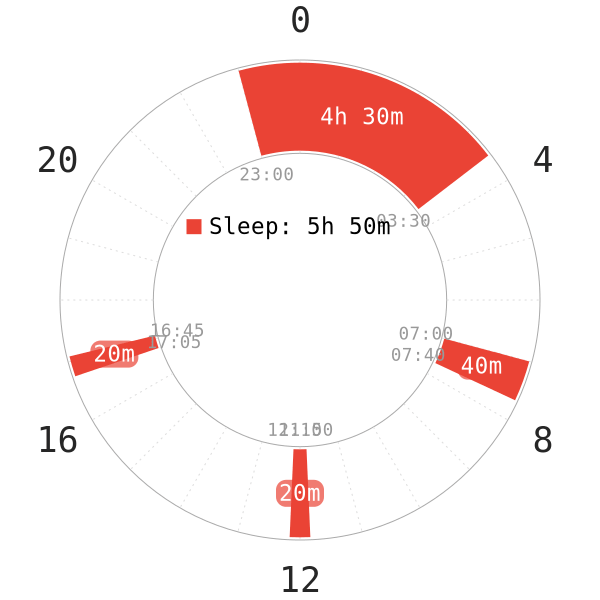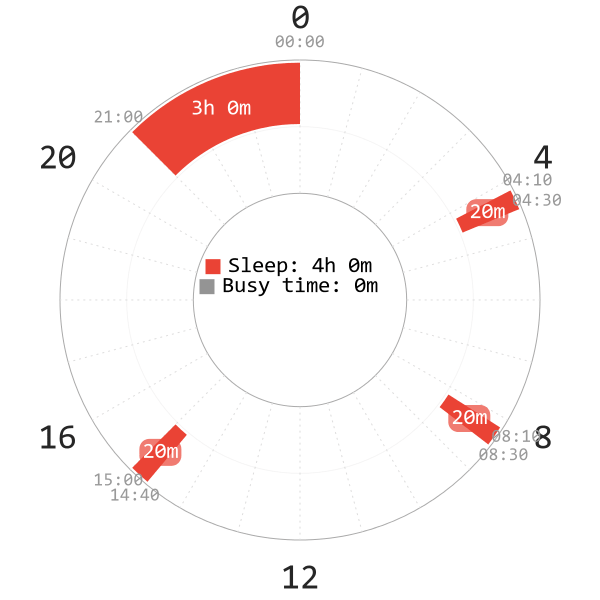
Everyman 3, or E3, is the original Everyman sleep schedule. Puredoxyk invented it following the extremity of Uberman. It used to be the only Everyman schedule, before E2 and E4 came along. Following the naming scheme of polyphasic schedules, E3 has 1 core sleep and 3 20m naps.
Content
- History
- Mechanism
- Adaptation
- Alternate Variants
- Lifestyle Considerations
History
Since the history of Everyman 3 directly ties with the Everyman system as a whole, refer to Everyman page for more details. It is a core schedule of the Everyman line, before variations such as E2, E4 came along.
There has been a few changes in Everyman 3’s scheduling over years. Puredoxyk’s original E3 has the core near midnight, which is considered late for an E3 core; the quality of SWS can quickly deteriorate. Now, the standard variant has the core occupy most, if not all of the SWS peak hours.
Currently, Everyman 3 is the most sought after schedule thanks to Puredoxyk’s inspiration with her book. The seemingly convenient scheduling structure and an astounding amount of sleep reduction buffed its popularity. In the recent years, E3 remains one of the top-tier polyphasic schedules that many embrace.
Even though there has been a whopping amount of adaptation failures over the years, the heat around E3 has never subsided. As of late, there have been more options to schedule E3; this in return further cements E3 at the top spot for usage with admirable versatility.
Mechanism
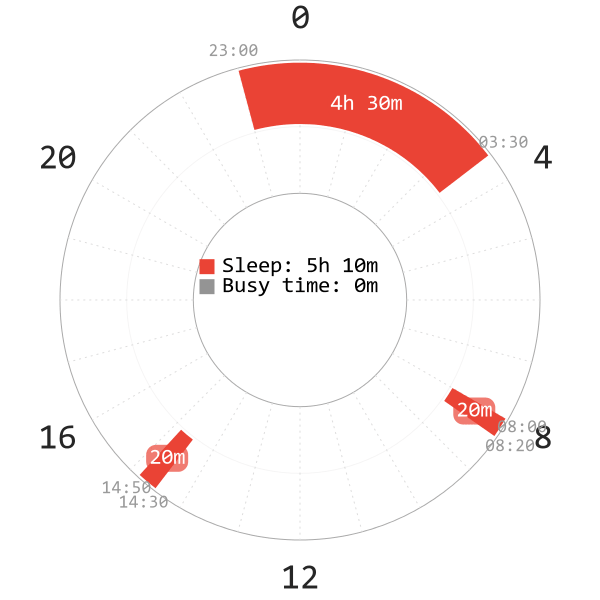
Core sleep
- Following from E2, Everyman 3 further removes a full cycle from the core sleep and adds the third 20m nap.
- The core sleep on E3, lasting for only ~3-3.5h, accounts for only 2 full sleep cycles.
- Four hours total daily sleep is considered the minimum to sustain 90m SWS, 90m REM, and transitional light sleep.
- The most important scheduling requirement is having the core cover the circadian SWS peak between 9PM and midnight.
- 9PM is the ideal start time, but 10PM is also permissible.
- Rotating the schedule further is very difficult, and requires stringent management of light, food, and possibly temperature cues to maintain a circadian rhythm later than natural daylight.
- An ideal E3 adaptation would have the entire SWS needs covered in the core, and SWS is going to be extremely tight in the first cycle. The second cycle will then allow some amount of REM sleep. The naps will carry the remaining REM requirements.
Naps
- Similar to other schedules, 20m naps are superior to 30m naps or longer naps, especially on E3. This is because they prevent SWS wakes from the start of adaptation and are generally easier to handle.
- The first 2 naps will most likely be full of REM sleep.
- The third nap varies in successful adaptations.
- It may contain exclusively light sleep if it starts later than a certain benchmark for the REM circadian. For example, if the third nap is after ~3-4 PM, the chance for a REM nap is lower than earlier naps in the day.
- Individuals with low REM requirements may only have light sleep in the last nap.
- Because of the reduced total sleep, each nap on E3 will not sustain wakefulness for a period as long as the naps on E2 or any other extended variants.
- The ideal wake gap from the core to the first nap is anywhere around 3-4h, 4-5h between the first 2 naps, and then up to 7h (not recommended to be longer than 8h) between the third nap and the core.
Even though social time in the evening becomes null on regular Everyman 3, one takes two naps before heading out to work or starting the day. The remaining nap is during some breaks in the afternoon. This allows for more chance to dodge daytime commitments that can usurp nap times if there is more than one daytime nap.
Adaptation
Everyman 3’s total sleep is at the minimum sleep threshold for long-term maintenance.
- SWS is a massive roadblock during adaptation. Repartitioning all SWS into only two cycles makes this schedule extremely difficult by the second and third week of adaptation. At first, SWS spreads out up to the third sleep cycle, or even in later cycles in the morning on monophasic sleep. This is especially true in the case of poor sleep hygiene or pre-existing sleep deprivation.
- When the core is suddenly shorter, SWS wakes may become frequent in the core. This leads to many reported oversleeps. Even worse, the naps can also give SWS wakes; SWS deprivation symptoms become clearer during adaptation.
- It is also common to experience or feel cold after waking up from the first nap, or near sunrise hours; this is because the core body temperature is still adapting to the new sleep regime. Core body temperature is often at its lowest around these late night/early morning hours.
- Many weeks of little to no oversleeps and utmost consistency in sleep times are mandatory to eventually reach an equilibrium of SWS and REM on schedule.
- Eventually, naps should no longer have SWS episodes. The early REM-favored placement of the three naps helps to reinforce this. 4AM, 8AM, and 2:30PM naps are ideal with a 9PM core.
Cold Turkey
A large majority of successful Everyman 3 adaptations comes from the cold turkey method. The time it takes to adapt to E3 is potentially shorter than to 2 schedules in the gradual adaptation method. Because of the lower total sleep, it is also expected that vital sleep will be repartitioned into each sleep block faster than those on E2 or E1.
Thanks to the high sleep pressure overall, adaptation duration on E3 is often shorter than those on E1, based on the successful accounts. However, a failing adaptation due to skipping naps, flexing naps, moving the core sleep, wrong assessments of personal monophasic sleep needs, or a poor diet/exercise/substance planning can drag out Stage 3 for an extended period of time.
Gradual Adaptation
It is possible to transition to Everyman 3 from E2 or even E1 by cutting out some portion of the core sleeps and add naps accordingly. However, there are very few sleepers who have been able to transition and adapt to E3 from E2.
The gradual adaptation route is often too long in the grand scheme of things; challenging adaptations to E1 or E2 can be overbearing for any new polyphasic sleepers.
It is therefore necessary to stay adapted on E1, or mostly E2 for some months before considering adapting to E3. This can gauge for the personal ability to sustain a reduced sleep total on E2 comfortably, to make sure there is any good shot at E3. An unstable E2 or E1 adaptation will quickly tell the story that E3 is an unrealistic goal. An E3-extended version would then become necessary.
Rhythmic Preservation
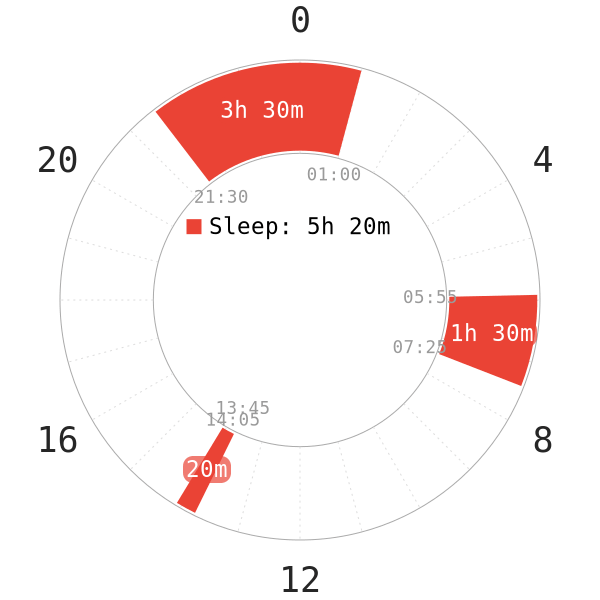
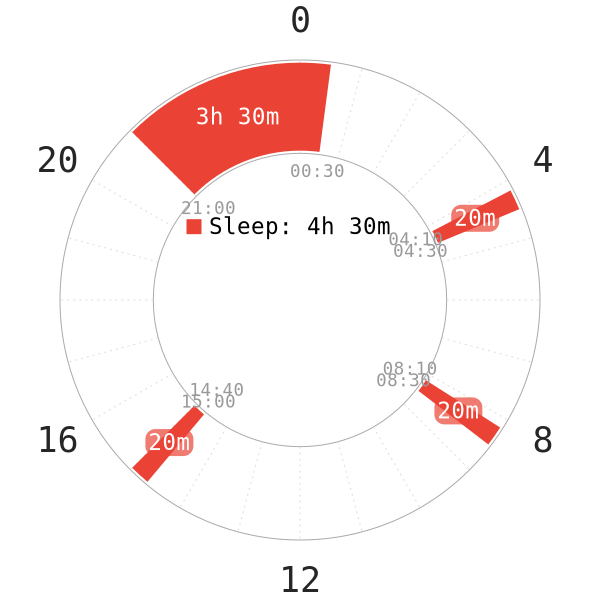
Interestingly enough, it is possible to transition from DC1 to E3 via the rhythmic preservation method. The first core of DC1 starts and potentially ends at the same time as the E3 core. As the second core of DC1 reduces to a nap, there are two extra naps to now form E3. Additionally, this adaptation route originated from Polyphasic Society.
This is possibly the only viable way to transition from a Dual Core schedule to an Everyman schedule. While the primary strategy is to utilize the 3.5h core duration, there has been very little success with this adaptation method.
Naptation
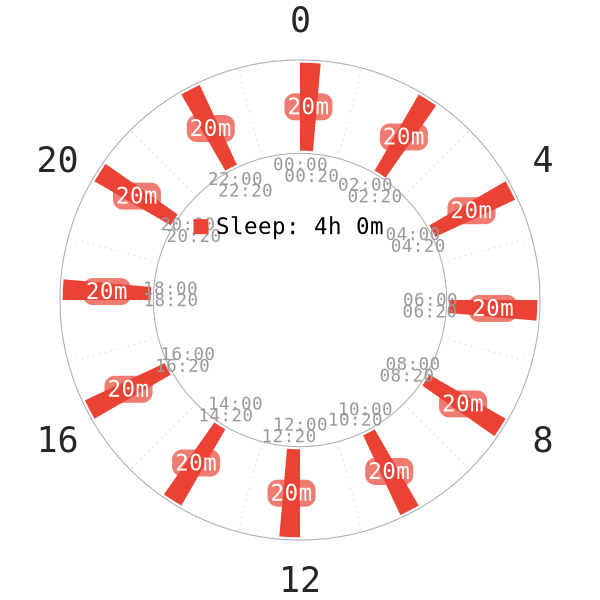
This adaptation protocol to E3 used to be popular; the whole idea is to learn to nap until one crashes and falls back on E3. However, it is unadvisable recently, especially if one dives into E3 right after doing naptation. The primary reason is that starting an adaptation with sleep debt only inflates the difficulty of the adaptation and leads to unwanted oversleeps right in the first couple days.
Fully recovering on monophasic from the sleep debt of naptation as a process of learning to nap before attempting E3 would be a more sensible route. As adaptation goes on, the sleep pressure from a shortened core sleep will facilitate falling asleep in the naps sooner than on schedules with higher total sleep. Therefore, naptation is for the most part an unnecessary method.
Reverse Gradual Adaptation
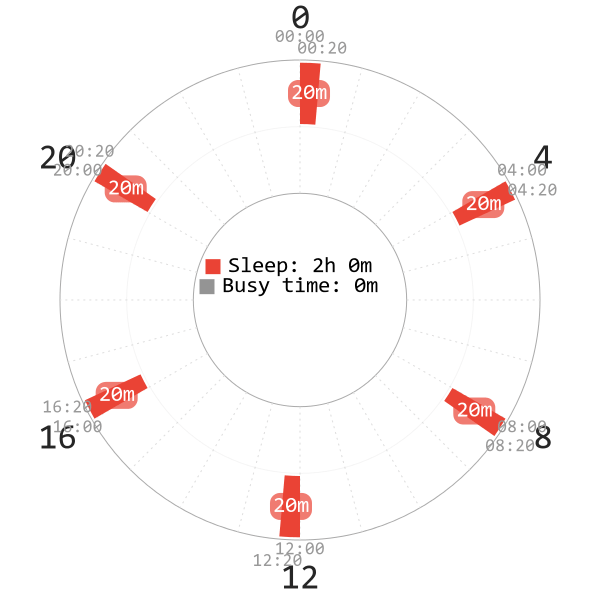
The reverse gradual adaptation method also used to be very popular. The strategy is as follows:
- Attempt to schedule Uberman sleep with 6 naps as usual, but not to adapt to it.
- After some days, the next step is to jump into E3, taking advantage of the insurmountable sleep pressure from the Uberman.
- By anticipating the incoming “oversleep”, one can then choose one of the Uberman naps (typically the one around evening hours) to become an E3 core with a desired length of choice (e.g, 3 or 3.5h core).
While this method has largely discontinued recently, it did have some success over the long history of E3 attempts. Same as Naptation method, starting an E3 run with pre-existing sleep debt from Uberman is not recommended. This potentially only makes adaptation harder than it already is.
A recovery on monophasic sleep after Uberman (as a process of learning to nap in 20 minutes) would be better than a direct transition. The body also needs a period of time to get used to a new sleeping pattern as a result of the breakdown of the core sleep into purely 20m naps before there is a resurgence of the core sleep again.
Alternate Variants
Everyman 3 is a polyphasic schedule that truly lives up to the expectation. Documented success over the years has nourished the standard scheduling and even created more alternatives to attempt, with a decent possibility to succeed.
Midnight Core
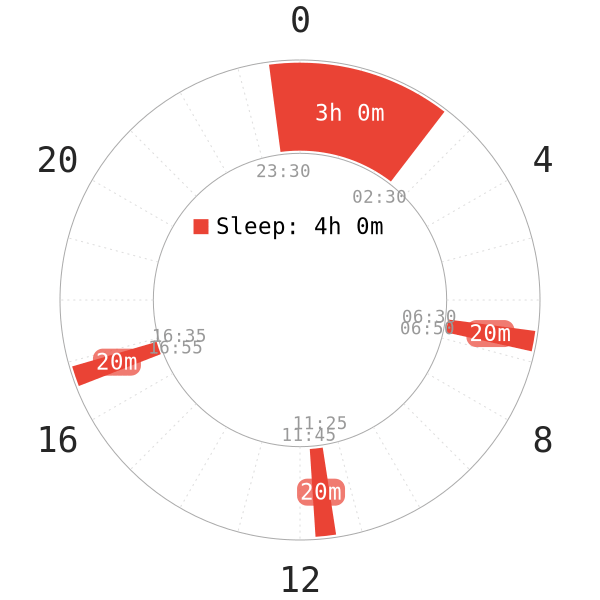
Puredoxyk originally mapped this out and made it a standard variant.
- The core is at late hours in the SWS peak, which also forces a rotation of nap timing.
- In this setup, social life can be more manageable in the evening with the opportunity to wake up and start the day very early.
- One takes the first nap before the day actually starts (for other regular monophasic sleepers).
- 2 naps are for during work breaks (lunch break and after work).
- In a way this scheduling resembles DC2, whose naps are at similar hours.
- There is also a choice of scheduling a 3.5h core for the matter of personal preference, Puredoxyk explained.
However, there has been limited success with this scheduling over the years. This is largely attributed to the lackluster amount of SWS that the core cannot reliably sustain. In addition, SWS can creep into the last nap. Only individuals with low SWS requirements would enjoy this variant; it is similar to E2’s scheduling, except more extra wake time.
Dawn Core
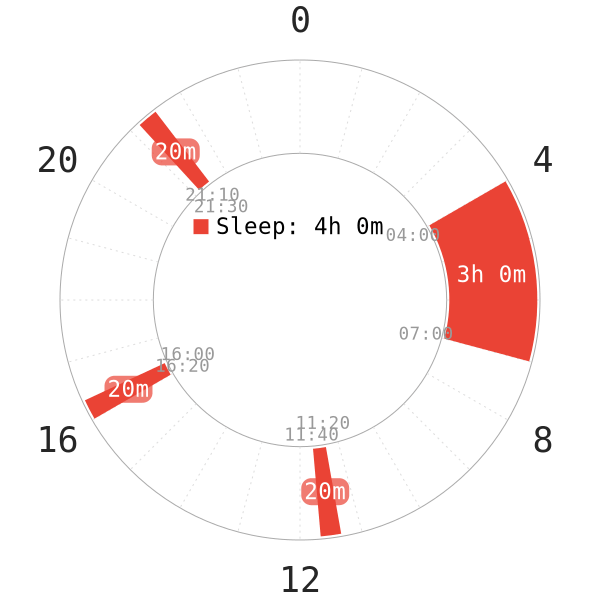
Puredoxyk successfully adapted to this Everyman 3 variant at some point. However, she was also known to be a very heavy insomniac, whose sleep requirements are very low overall. The chronic sleep interruptions troubled her when she had to sleep monophasically.
This is a very extreme way to schedule E3. It is unadvisable to schedule this Everyman 3 because:
- The core around sunrise hours will create a confusion in circadian rhythm. These hours usually favor REM sleep, while the core is supposed to cover all necessary SWS.
- It is doubtful if an average sleeper with normal SWS requirements would be able to adapt to this E3; there have been basically no reported successful adaptations ever.
- The rotation of the naps also moves the last nap into SWS peak hours. This can be absolutely overwhelming to wake from when SWS pressure rises.
Considering all elements, inexperienced sleepers or beginners should avoid this variant entirely.
3.5h Core
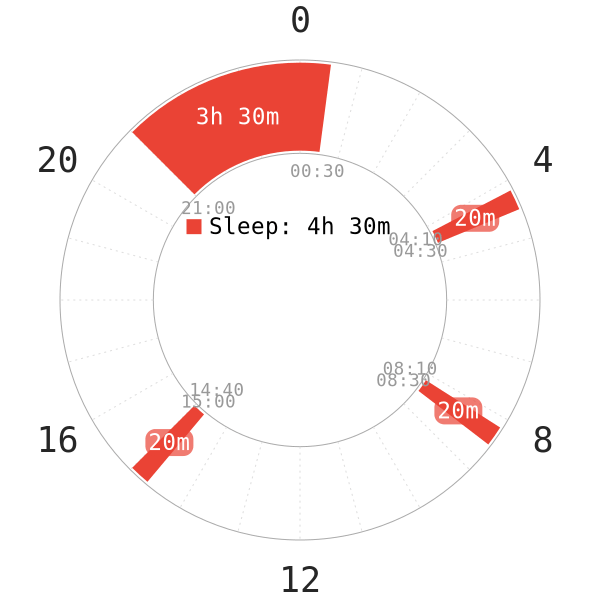
Nowadays, this core length has been more popular for an Everyman 3 adaptation rather than the 3h core. The total sleep is similar to Triphasic, hovering around a more comfortable sleep total for experienced or highly motivated attempters. The same principles that apply to the 3h core also apply to a 3.5h core.
- The core sleep should not start any later than 10-10:30 PM, to retain sufficient amount of SWS.
- If all SWS has been secure, the +30m from 3-3.5h mark can give more light sleep or REM sleep, to match personal REM baseline more comfortably. This is also a core duration that originated from Segmented sleep; additionally, this core also lies in the SWS peak for the same purpose.
- The naps behave in a similar manner as the 3h core version. Two naps before going out in the morning, and one daytime nap.
- It may be possible to gradually transition from Segmented sleep (with a 3.5h first core), a scheme from Polyphasic Society to get to E3. However, it is unknown if anyone has been able to pull this off.
There are certain benefits of a 3.5h core.
- The flexibility of the core sleep after adaptation. ~15-30m earlier or later than the original time should be realistic.
- The flexibility of the last nap, or the second nap as well. Contrary to other polyphasic schedules with 4-4.5h total sleep, this 3.5h core version seems to be the most flexible.
However, adaptation remains very punishing for any oversleeps as long as ~1h at least. The exhausting process of repartitioning will also ramp up around the second or third week. First-time polyphasic sleepers should aim for this variant to stay at a safer amount of total sleep and a somewhat milder adaptation than the original version.
Extended
E3-extended has a variety of tricks to help accommodate different forms of scheduling. Beginners may attempt E3-extended.
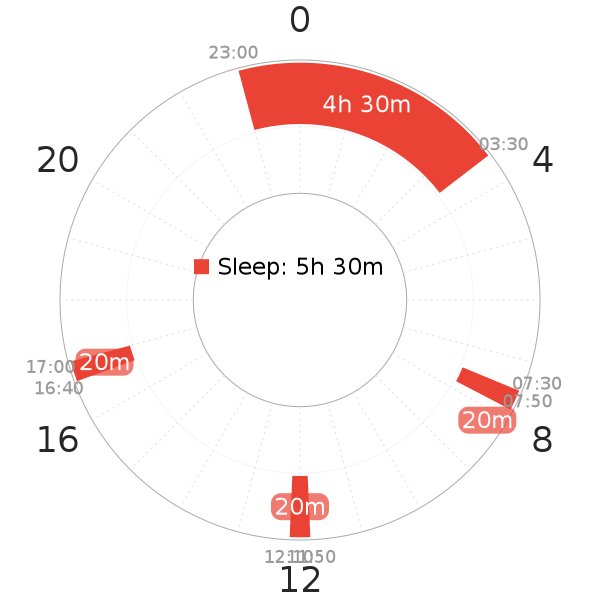
Even though the regular version was mostly practiced after the release of Ubersleep, there were a lot of questions about the viability of an E3 variant with a 4.5h core instead.
Puredoxyk later clarified on the matter and said it is a decent option; it mostly intends to be a “happy E3” variant. Currently, the Polyphasic Discord Community has named it “E3-extended” because of the addition of 1 full sleep cycle to the 3h core.
There are in fact reasons why E3-extended is along the lines of a “happy” polyphasic schedules.
Adaptation Difficulty
- The adaptation process is much tamer than with a 3h core. The extension of the core sleep, which also makes it the same core length as E2, allows ideally all SWS to remain intact during adaptation.
- As SWS deprivation symptoms almost do not exist on the schedules (except bad sleep hygiene or high SWS needs), the adaptation centers on repartitioning REM sleep. This allows REM sleep to appear at earlier periods in the core cycles.
- The last nap likely contains only NREM2 to sustain alertness; meanwhile, the other two naps are still replete with REM sleep.
- The overall sleep pressure on this schedule is much more tolerable than E3. In terms of difficulty, it has reported a good wave of successful adaptations even from beginners; thus, is a very reliable way to adapt to an Everyman schedule with 3 naps.
- It is possible to transition from an adapted E1 schedule to E3-extended, which is of moderate difficulty for this gradual adaptation. There have been a successful example in the community who followed this pathway.
Utilities
- E3-extended has a higher nap frequency than E2. This makes it less stressful to stay awake until the next nap as they are closer to each other. During adaptation, if one nap is skipped, it will provide more opportunities to fall asleep in the next nap even in the early stage of adaptation. After adaptation, the process will also be less painful with one skipped nap, as long as this does not occur too often.
- A 4.5h core also validates the later start time. Unlike E3’s core, on E3-extended the core can start at midnight, or even some time after midnight. The naps will have to rotate along. More awake time in the evening is what many people are after; as a result, this is an advantage compared to most multi-core schedules.
- E3-extended can become very flexible after adapting, with the possibility to transition to SEVAMAYL as the most ideal base schedule.
- The core duration, which can cover a decent amount of REM sleep, puts less pressure on the naps to achieve the same task.
- The naps can be flexible to great extents while still fulfilling the remnant REM requirements.
- There have been reports on the ability for the core to receive natural wakes after adaptation. The reduction to ~4h core duration is possible as a result of many weeks staying adapted.
- E3-extended supports heavy physical exercises a lot better than E2, thanks to the addition of a nap. This will then create more space in the core for more SWS.
Because of having 3 naps, E3-extended does not have much variation in scheduling as the naps are mostly locked into these convenient spots of the day. The wake gap from the last nap to the core is usually the longest among other wake periods during earlier daytime hours.
Pronap
- It is also important to note that using a Pronap on regular E3 versions is very discouraged. This is because the 3 or 3.5h cores cannot cover all SWS needs when adaptation first begins. Extending the first nap will only increase the chance for an SWS wake; through many in-progress adaptations to Everyman schedules, many EEG readings do record SWS even in the first nap around REM peak.
- A Pronap is often for individuals with normal SWS but higher REM requirements to use this E3-extended variant.
Only sleep mutants or individuals with low SWS requirements should use a Pronap on the regular E3 version.
5h Core
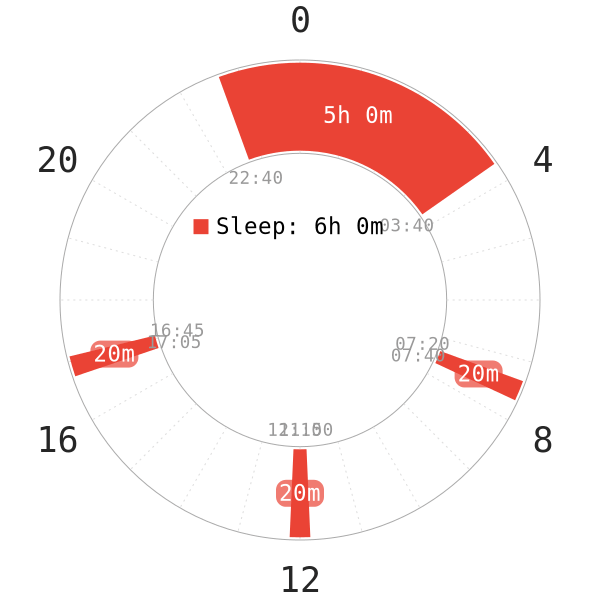
Since the 5h core duration has seen usage in a lot of adaptations, it is also possible on E3-extended. With the total sleep of 6h and a high frequency of sleep, this variant should suit people with very high monophasic requirements (e.g, ~9-9.5h monophasic) or people with huge SWS requirements. There have been very rare attempts, though.
Alternatively, a 5h core and a Pronap (~30-40m) can be an E3-extended variant; however, there is no success up to date. Other than that, this variant likely will not see much use because of its seemingly redundant amount of sleep. An E2 schedule with a 5h core, E2-extended or E1 with a 6.5h core are likely more convenient to schedule.
Lifestyle Considerations
Research
Interested in some research on E3? Click this link to learn more.
Niches
Everyman 3 overall has several niches that cater to many goals of polyphasic sleepers.
- E3’s core sleep is short enough to leave many wake hours during night time hours.
- The core is often around the hours that can be secure from daytime interruptions. However, evening social events are a bane for regular E3.
- The naps come in handy with scheduling.
- Each nap only lasts for 20m, so it is very easy to fit them into daily lifestyle.
- Flexible work hours or work-from-home jobs would have a field day with E3.
- The short duration of a nap does not often get into the way of many other daily commitments; in addition, a lot of casual people will not even notice that someone has taken a 20m nap nearby.
The Typical Trait of Everyman Schedules
The core of E3 amplifies the characteristics of a sleep pattern that bears striking resemblance to a massively reduced monophasic schedule
- This is a trait among Everyman scheduling prototypes, where the long core sleep gradually reduces from monophasic sleep.
- The core also accounts for the majority of total sleep.
- The only difference is the addition of the naps to alleviate homeostatic pressure.
Because of this, at least a couple adapted E3 sleepers report that E3 barely gives any sleep, or only 3h of sleep per day; the naps are so short even though there are 3 of them each day.
Similar to other schedules with low total sleep, days on E3 can last very long, and each nap provides REM sleep for refreshment. The short naps also do not give an impression of a burden of having to cool down and sleep for a long period of time like a core would.
As an added bonus, Everyman 3 is one of the prime polyphasic schedules for lucid dreaming. A lot of intense dreaming experiences, including false awakening dreams have been recalled from E3’s naps.
Extension
The extended version (4.5h core) has been a treasure for E3. It has reported a surprising amount of success that helps with the extra time.
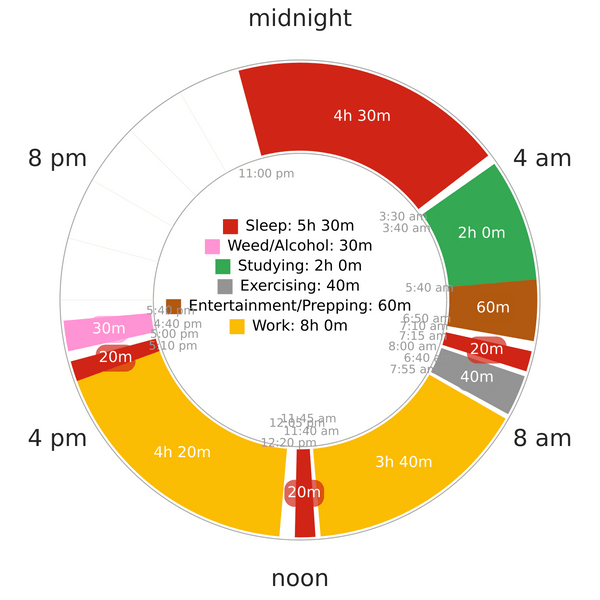
- The nap frequency helps prevent the strain of having to stay awake for too long.
- Having a sweaty workout is tolerable.
- Even small amounts of alcohol once in a while are acceptable.
- The flexibility of the core after adaptation can be up to ~90m range (earlier/later than the original core time).
The 4.5h core has since been a golden core duration that hits many birds with one stone. It is a hallmark sleep duration that makes Everyman 3 even greater today. E3’s scheduling also allows it to be viable for mainstream 9-to-5 occupations, if napping is possible at work.
Despite Everyman 3’s greatness and popularity, it is essential to carefully look over daily commitments, sleep habits, meal plans and other habits that can negatively affect polyphasic adaptations, especially those of E3 tier (e.g, smoking, being consistently sleep deprived on monophasic).
A highly challenging adaptation phase will open the gate to the extra time and rewarding productivity once the naps have ingrained.
Main author: GeneralNguyen
Page last updated: 8 April 2021

